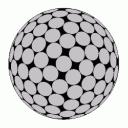Yahoo Answers is shutting down on May 4th, 2021 (Eastern Time) and beginning April 20th, 2021 (Eastern Time) the Yahoo Answers website will be in read-only mode. There will be no changes to other Yahoo properties or services, or your Yahoo account. You can find more information about the Yahoo Answers shutdown and how to download your data on this help page.
Trending News
Frame of Regular Tetrahedra?
You have sufficiently many congruent regular tetrahedra - #1 on the following picture:
http://farm4.staticflickr.com/3819/9292316519_a090...
You begin joining them face-to-face: joining the second tetrahedron to the first, you get a regular triangular bipyramid (#2); then you join the third tetrahedron to one of its faces (#3) and so on. Let the joined tetrahedra form a chain so that each of them (except first and last) shares exactly 2 faces with its neighbors (unlike #4). Can the chain close in a frame-like construction, i.e. the first and last to be joined precisely face-to-face too?
For example 8 congruent cubes make an obvious frame (#5) with a cubic hole (how convenient are these right dihedral angles!), but somebody might be surprised that 8 congruent regular octahedra do it also (#6)! The success of the latter construction is due to the fact that the dihedral angle between 2 faces, sharing a common vertex, but not a common edge, is θ = arccos(1/3); the dihedral angle between 2 faces, sharing a common edge is exactly π - θ. But in the regular tetrahedron the only dihedral angle is θ.
Many irregular congruent polyhedra also make frames, remind the prisms in the famous Rubik's Snake:
http://farm3.staticflickr.com/2818/9365192264_31d4...
But no cubes. No octahedra. Regular tetrahedra only. Their centroids need not be coplanar (like the centers of the 8 cubes above), but remember, not edge-to-edge or vertex-to-vertex joinings as these kaleidocycles:
http://www.mathematische-basteleien.de/kaleidocycl...
All to be joined face-to-face, or "cheek-to-cheek" - this may inspire you:
http://www.youtube.com/watch?v=A7rmQuvuyz0
This question may turn out difficult and the web search I made (I am not sure I did it thoroughly) didn't help - such rigid frame seems highly unlikely with only dihedral angle θ available, but I can neither prove, nor disprove it is possible.
To get into a good shape, try another much easier problem: prove that the only convex polyhedra - unions of joined face-to-face congruent regular tetrahedra - are the tetrahedron itself and the triangular bipyramid (#1 and #2).
Scythian: That's right, I have commented some 3D tessellations in my answer to Pauley Morph's question (# 7):
http://answers.yahoo.com/question/index;_ylt=Aj.gp...
JB: Hi and welcome back to Y!Answers! Very glad that you like Louis Armstrong and Ella Fitzgerald - these great names in jazz from the time when people like me were young! As to the question, my intuition says the same, I also would like to see an eventual proof, but I don't know if somebody has looked into it. Any knots allowed, the only requirement to be the tetrahedra to dance cheek-to-cheek!
To All: Many thanks for the interesting answers - I promise to keep the question open as long as I can!
FINAL REMARKS: I have three books by Hugo Steinhaus at home, but I feel almost ashamed that I didn't know this problem has been posed by him and solved more than half a century ago as pointed by the answers below. The answers were extremely helpful, I can see how much zeal and efforts are there in some of them and I would like to have a possibility to award several Best Answers. Many thanks to Scythian, JB, Jibz, Gianlino, Fred and Stan! But Aamir Mohammed, you should know that the experimental approach you suggest goes best if you wish for example to find a cure against AIDS - you must try and try tirelessly - and if you are successful you could win the Nobel Prize for Medicine! Alas, in Mathematics this approach is unacceptable.
Finally, several words about the accompanying problem - convex polyhedron of this kind can have polyhedral angles with angular defects of 120° or 180° (other cases easily excluded), so in each vertex there are linear angles 3 * 60° or 4 * 60°.
Since the
(CONTINUED)
Since the total defect is 720°, if v₃ and v₄ are numbers of vertices with 3, respectively 4 edges, then the only solutions of the equation
v₃ * 180° + v₄ * 120° = 720° are v₃ = 4, v₄ = 0 (tetrahedron) and v₃ = 2, v₄ = 3 (bipyramid).
7 Answers
- gianlinoLv 78 years agoFavorite Answer
The answer is no. Suppose you have a chain of tetrahedrons with centers A_0, A_1..... A_n. You can set up coordinates so that A_0A_1 is a unit vector e_0. For all k, denote e_k the vector A_kA_(k+1).
Then one can show, by induction, that for all k, and for all chains
e_k * e_0 is of the form p_k / 6^k, where p_k is not a multiple of 3.
Hence A_0A_n * e_0 = sum [k=0,n-1] p_k/6^k can be rewritten as q_(n-1)/6^(n-1) where q_(n-1) = p_(n-1) [3] so that it is not a multiple of 3, and hence does not vanish. Therefore A_n and A_0 can never coïncide.
The ingredients for the induction are elementary. Just observe that e_0 and e_1 being given, you have 3 possibilities for e_2
e_2 = 2e_1/3 - e_0
or
e_2 = e_1 / 6 + e_0 / 2 +- (sqrt(3)/2) (e_0 x e_1)
and similarly for e_(k+1) with e_(k-1) and e_k given. These relations allow you to express e_k * e_0 by induction.
- JBLv 78 years ago
Hi Duke. Thanks for the Louis Armstrong & Ella Fitzgerald link. That was a surprise. My intuition says it is not possible, but that you can come arbitrarily close. I would like to see a proof. In the meantime I will play with it. BTW, are knots allowed?
--------
Edit: Google search shows that this same question was asked by Sergei Markelov in the MathForum@Drexel in 2004. Robin Chapman pointed out that it could be reduced to a problem in combinatorial group theory, and Randall Dougherty then replied:
"There are no nontrivial relations among R_1,R_2,R_3,R_4; this is
a result of T. J. Dekker (Nieuw Arch. v. Wiskunde (3) 7 (1959), 57-60).
It follows that there is no chain of tetrahedra as above, but that
result had been proved earlier by Swierczkowski (Indag. Math. 20
(1958) 376-378). The problem was posed by Steinhaus in 1956.
This information comes from chapter 5 of "The Banach-Tarski Paradox"
by Stan Wagon."
see: http://mathforum.org/kb/thread.jspa?threadID=97163...
where you can see the thread.
I see gianlino has provided a proof, and someone else mentions similar to the above.
Please leave question open a bit longer ...
Last Edit: Here are some images of failed rings that I created, just for grins:
http://i39.tinypic.com/zuf24y.png
http://i41.tinypic.com/dvlm2x.png
http://i41.tinypic.com/vcs87s.png
http://i43.tinypic.com/jt6sqr.png
If you start with a tetrahedron in the cube (+-1,+-1,+-1) with edges as certain face diagonals, then all tetrahedra in any chain built from that one as a starting cell will have rational vertex coordinates and all denominators will be powers of 3, with increasing maximal exponent for each new cell added to the chain. Gianlino proved by induction (for the centers) that this continues and therefore precludes any cell after the first from having integer coordinates, so closure of a chain is impossible. This was also discussed and mostly proved by Scythian. Such proofs seem easier than those mentioned in the literature.
- FredLv 78 years ago
I think gianlino has the proof of impossibility, though I haven't taken the time yet to walk through his argument.
But this puts me in mind of the general subject of regular polytopes, and the dualities in 3 dimensions of:
• cube-octahedron
• dodecahedron-icosahedron
• tetrahedron-tetrahedron
In n dimensions, dual figures can be placed concentrically, and oriented so that the k-dim elements of each figure correspond (perpendicularly bisect, or centrally displaced from that) the (n-1-k)-dim elements of the other. In n=3, this means that vertices (k=0) of one solid stand radially outside the face-centers (2-k = 2) of the other, and the edges (k = 2-k = 1) of each solid perpendicularly bisect each other.
For one thing, the closed chains you posit will each be a subset of a tessellation of the given polyhedron. So it isn't that surprising that octahedra can be chain-looped, given that cubes can be -- these two polyhedra exemplify the same symmetry group in 3-space. Chain-looping octahedra by their faces, is equivalent to chain-looping cubes by their vertex figures (so that they touch at their vertices, and oriented so that their vertex figures coincide), and that's a pretty easy thing to do.
For another, a tessellation of Euclidean n-space (E^n) with n-dim polytopes is a sort of degenerate case of an (n+1)-dim polytope. In the case of the regular 4-polytopes, there are 6 -- and if you visualize constructing them in similar fashion to the paste-along-edges, then fold-up-and-repeat-til-it-closes method for constructing regular polyhedra, you can go down the following path.
Suppose you start with equilateral triangles, and put 6 of them together around a common vertex to make a regular hexagon. Now remove one, and, with the remaining 5 still "hinged" on common edges, join the two open edges to form a pentagonal-pyramid "cup." That pattern can be repeated around all the other vertices, until it closes into a regular icosahedron.
Now try the similar strategy with regular tetrahedra, joined at common faces, surrounding a common vertex. You will find that you can get at most 20 of them into that cluster, but they don't quite close up (the 20 outer faces of each tetrahedron are trying to form a regular icosahedron, but they are just a little too far from the central vertex to join completely). That cluster can be closed by bending into the 4th dimension, making an icosahedral-pyramidal "cup." And continuing on that pattern, the figure eventually closes into a regular polytope with 600 tetrahedral "cells," or hyperfaces.
I suspect that the failure of those 20 tetrahedra to close, can be used somehow to show the impossibility of chain-looping regular tetrahedra.
Source(s): http://en.wikipedia.org/wiki/Regular_Polytopes_(bo... http://en.wikipedia.org/wiki/Regular_polytope - Scythian1950Lv 78 years ago
Getting into good shape, the hangup with regular tetrahedrons as a space-filling solid is that they have a 70.5288° face-to-face angle---you just can't go anywhere with that. That's why irregular tetrahedrons do the job instead, such as the one with edge lengths of 1, √2, √3. Several different kinds can fill space completely, but your question addresses regular tetrahedrons only.
Edit: Can you leave this open for a while longer? This is an interesting subject.
Edit 2: Taking a cue from gianlino's impossibility proof, we can start with a tetrahedron defined by
{ { {1,1,1}, {1,-1,-1}, {-1,1,-1}, {-1,-1,1} }
and then start generating all the other vertices added to this set by attaching a new tetrahedron to each exposed face. Let {a, b, c, d} be the 4 vertices of any tetrahedron. Then, if e is the new vertex created by attaching a tetrahedron to face abc,
e = (2/3)(a + b + c) - d
In this fashion, the first 4 new vertices are:
{ -5/3, -5/3, -5/3 }, { -5/3, 5/3, 5/3 }, { 5/3, -5/3, 5/3 }, { 5/3, 5/3, -5/3 }
Then the next 12 is are this form { p/9, q/9, r/9 }, and then the next 36 are of this form { p/27, q/27, q/27 }, etc, generally of the form { p/3^n, q/3^n, q/3^n }, where n is the index for successive generations.
The crux is that if A, B, C, D are vertices of previous generations, each of the form { p/3^n, q/3^n, q/3^n } for some n or less, then (2/3)(A + B + C) - D always results in a new vertex of the form { p/3^(n+1), q/3^(n+1), q/3^(n+1) }, and never reduces to a denominator with a lesser power of 3.. Part of the necessary condition for this that the vertices A, B, C, D used to generate the next are always mixed, i.e., not all of the form k/3^n for any one single n. I'll get back to this later when I get the time. This is similar to gianlino's proof, except that it's possible to look at this entirely in terms of rational numbers.
Edit 3: Sort of proof by induction: Let E be the new vertex generated by reflection from D by the A, B, C plane, so that the next new vertex F will be (2/3)(A+ B + E) - C or (2/3)(B + C + E) - A or (2/3)(C + A + E) - B. Let's assume that E is of the form { p/3^z, q/3^z, q/3^z }, where z is > than w, x, y of that of A, B, C. We end up, for example, with (1/3^(z+1))(2*3^(z-w)ai + 2*3^(z-x)bi + 2ei - 3^(z+1)ci) = (1/(3^(z+1))(3N + 2ei), where i is the vector index, and 2ei is never a multiple of 3. Thus, the new vertex has to have the form { p/3^(z+1), q/3^(z+1), q/3^(z+1) }, which is also greater than the other vertices that will be used to generate the next new vertex. More importantly, the power of the denominator never reduces, thus the impossibility of this ever returning to (1,1,1}, {1,-1,-1}, {-1,1,-1}, or {-1, -1,1}, meaning that it can't return into the position of the original tetrahedron.
I see now that looking in Stan's book, "The Banach-Tarski Paradox", the proof given is similar to using the vector reflection method that I'm using here.
Edit 4: As an example, starting with the original tetrahedron, attach a succession of tetrahedrons to the chain that all share the edge from {1,1,1} to {1, -1, -1}. The new vertices generated will all lie in a circle of radius √6 centered at {1, 0, 0}, and they are, successively:
{ -1, 1, -1} (original vertex reflected into the next)
{ 5/3, -5/3, 5/3 }
{ 31/9, -1/9, 1/9 }
{ 53/27, 43/27, -43/27 }
{ -65/81, 95/81, -95/81 }
{ -283/243, -197/243, 197/243 }
{ 991/729, -1249/729, 1249/729 }
{ 7445/2187, -725/2187, 725/2187 }
{ 14719/6561, 9791/6561, -9791/6561 }
etc. This is true of any chain created with this regular tetrahedron. Obviously, with this example of chained tetrahedrons repeatedly going around that one edge from {1,1,1} to {1, -1, -1}, one can come arbitrarily close to the original tetrahedron, but never exactly matching it.
- How do you think about the answers? You can sign in to vote the answer.
- Anonymous8 years ago
The thing you are asking about is called a "Steinhaus Snake". A proof that such a thing can never close up is in my book, The Banach-Tarski Paradox (Cambridge U Pr, 1985), p. 69. It is not too hard, using barycentric coordinates and linear algebra. The first to solve it was S. Swierczkowski in 1958.
Ah: I see that the same answer has already been given...
Stan Wagon
- jibzLv 68 years ago
edit 0:
I'm pretty sure i've seen somewhere that these moves form a free group, i.e. you can only get back to the start by reversing the steps. A good book is Stan Wagon's "The Banach-Tarski Paradox".
- 8 years ago
cut numerous triangles out of cardboard...and fold the three smaller triangles into forming a tetrahedron
stick the faces using cello tape
make many of them
and try connecting them face to face using glue...
and see whether it can form a chain
may be that cud help







